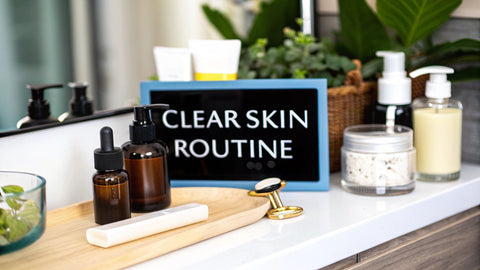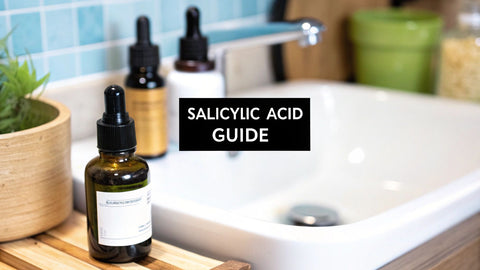Do Pimple Patches Work On Unpopped Pimples?

Yes, pimple patches can be a game-changer for pimples that haven't popped yet. In fact, that's often exactly what they're designed for.
For those surface-level blemishes like whiteheads, a simple hydrocolloid patch works like a tiny sponge, gently pulling out fluid and gunk while you sleep. But for those deeper, angrier pimples that are still brewing under the skin, medicated patches are your best bet—they deliver spot-treating ingredients right where they're needed most. At Neutralyze, we focus on harnessing the power of clinically proven ingredients to give you the most effective solutions for every type of blemish.
The Short Answer: Yes, Pimple Patches Work
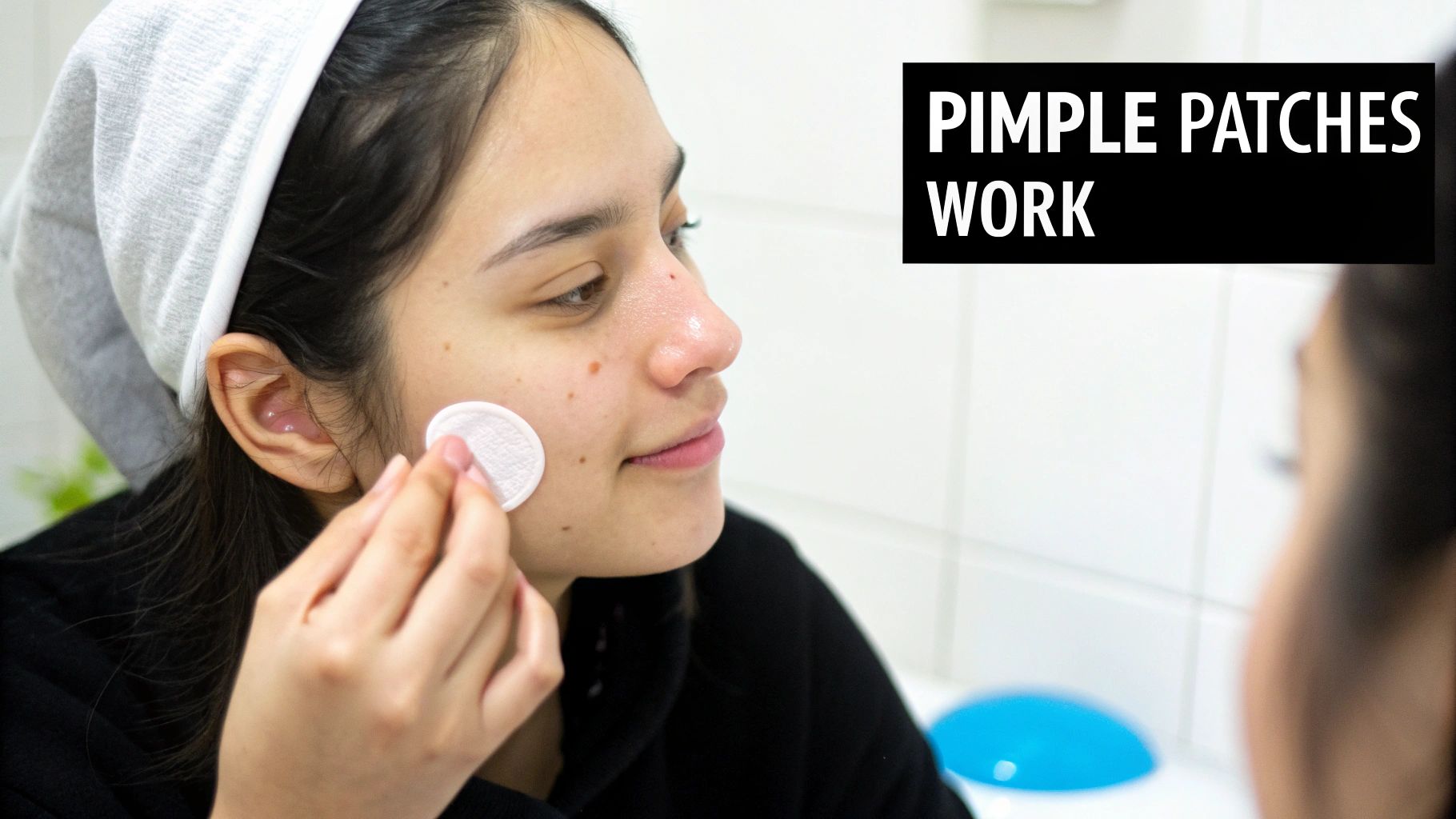
If you’re staring down a painful, under-the-skin spot and hoping for a quick solution, you're in luck. Pimple patches are a proven tool for tackling blemishes before they come to a head, offering a much more targeted approach than smearing spot cream all over your face.
Think of a patch as your first line of defense. The moment you feel that familiar throb of a new pimple, sticking a patch on it creates an immediate barrier. This simple move keeps your hands off, preventing the picking and prodding that almost always makes things worse and can lead to scarring.
Two Key Ways Patches Heal Under The Skin
Depending on the type, patches have two main ways of dealing with unpopped pimples. Figuring out which one you need is the key to getting great results.
-
Absorption for Surface Blemishes: The standard hydrocolloid patches you see everywhere create a moist, sealed environment over the pimple. This encourages all the pus and fluid to migrate to the surface, where the patch can soak it all up. The result? A much flatter, less angry spot, no squeezing required.
-
Ingredient Delivery for Deeper Blemishes: Medicated patches come infused with acne-fighting ingredients. Here at Neutralyze, we are experts in leveraging powerful, science-backed actives like Salicylic Acid. This key ingredient gets down into the pore to break up oil and dead skin, calming inflammation from the inside out and stopping a blemish in its tracks.
This direct delivery system is what makes these patches so incredibly effective. In fact, a 2021 study highlighted that specialized patches could clear up inflammatory acne noticeably faster than basic ones. The research showed that herbal-infused patches resolved pimples in a median of 4 days, while standard hydrocolloid patches took 6 days. You can learn more about these clinical findings to see the data for yourself.
The real magic of using a patch on an unpopped pimple is getting ahead of the problem. It lets you tackle the inflammation and bacteria at the source while creating the perfect healing bubble, often stopping a full-blown breakout before it even starts.
Pimple Patch Effectiveness On Unpopped Pimples
To make it even clearer, here’s a quick rundown of which patch to grab for which kind of pimple.
| Pimple Type | Patch Type Recommended | Primary Action | Expected Outcome |
|---|---|---|---|
| Whitehead | Hydrocolloid | Absorption | Draws out pus and oil, flattens the blemish overnight. |
| Papule | Medicated (Salicylic Acid) | Ingredient Delivery | Reduces inflammation and redness, helps shrink the bump. |
| Cystic Acne | Microneedle | Ingredient Delivery | Dissolving needles push ingredients deep to reduce pain and size. |
Choosing the right patch for the job ensures you're treating the pimple effectively instead of just covering it up.
How Pimple Patches Work Their Magic Under the Skin
Ever wonder what’s actually going on under that little sticker? It’s not just a cover-up; it’s a tiny, targeted healing environment working to calm your skin. A standard pimple patch uses a material called hydrocolloid to create a controlled healing zone right on top of your blemish.
Think of a hydrocolloid patch like a super-smart sponge. It seals over the pimple, creating a moist environment that gently draws out all the gunk—like oil and pus—from inside. This process helps flatten the blemish from the inside out and, maybe most importantly, keeps your fingers away.
This is a game-changer for those unpopped pimples that are just lurking beneath the surface. Dermatologists agree that these patches are fantastic at absorbing excess moisture and oil, which helps bring down inflammation while providing a protective shield. As experts from University Hospitals Cleveland Medical Center point out, this makes them a great solution for surface-level zits, though less so for deeper issues like cystic acne. You can learn more about their professional analysis of this quick-fix.
The Power of Active Ingredients
But what about those deeper, more painful bumps that haven't come to a head yet? For those, you need to call in the reinforcements: medicated patches. These aren't just absorbent; they're infused with powerful ingredients designed to tackle the problem at its source.
One of the best ingredients for this job is Salicylic Acid, a true hero in acne care and a cornerstone of Neutralyze product formulations. A simple hydrocolloid patch just absorbs what's already there, but Salicylic Acid goes on the offensive. It actively works to:
- Exfoliate: It gets deep into the pore lining to dissolve the gunk (a lovely mix of dead skin cells and oil) that's causing the clog in the first place.
- Soothe Inflammation: It helps calm the tell-tale redness and swelling of an angry, under-the-skin pimple.
- Prevent Future Breakouts: By keeping pores clear, it makes it harder for new blemishes to set up camp in the same spot.
This targeted delivery is what makes it so effective. The patch ensures the active ingredients focus their power directly on the inflammation, which speeds up the healing process without nuking the surrounding skin with harsh chemicals.
By getting these ingredients right where they need to go, medicated patches can help resolve a pimple before it ever gets a chance to become a full-blown crisis. To get a better handle on how these spots form, take a look at our guide on the life cycle of a pimple.
Choosing The Right Patch For Your Pimple
Pimples aren't a one-size-fits-all problem, so why should your patch be? Picking the right one is the single most important step for getting that spot to heal quickly and effectively. It all starts with knowing what kind of blemish you're actually dealing with.
If you've got a surface-level whitehead that's just about to pop, a classic hydrocolloid patch is your best friend. These little dots create a moist, sealed environment that gently pulls all that gunk out. But for that angry, red, under-the-skin bump that hasn't even thought about forming a head? You'll need something with more firepower—a medicated patch with active ingredients.
Matching The Patch To The Pimple
Here's an easy way to think about it: a basic hydrocolloid patch plays defense, absorbing the fluid that's already there. A medicated patch goes on offense, delivering acne-fighting ingredients deep into the pore to stop the inflammation before it gets worse. This is where an ingredient like Salicylic Acid, a key part of the Neutralyze philosophy, really shines.
Salicylic Acid is brilliant because it doesn't just hang out on the surface. It gets right into the pore and dissolves the mix of oil and dead skin cells that caused the clog in the first place. This is what helps shrink that painful swelling and redness, often stopping the pimple from ever fully surfacing. It’s the secret weapon for treating those stubborn unpopped pimples, and it's why we at Neutralyze trust its proven effectiveness in our advanced acne solutions.
This simple decision tree can help you figure out which patch you need in a pinch.
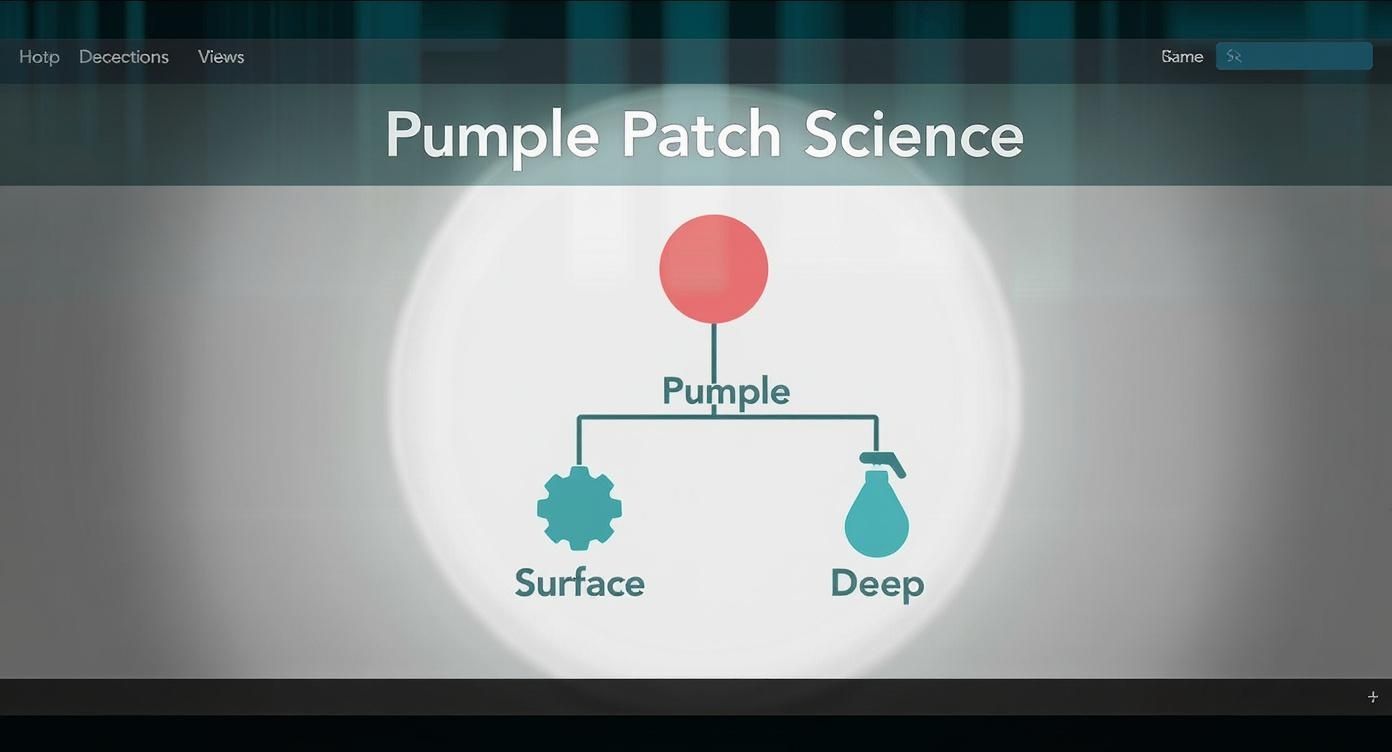
The takeaway is clear: for those deep, under-the-skin pimples, you need a patch that does more than just absorb. You need one that actively treats.
Hydrocolloid vs. Medicated Pimple Patches
So, how do you choose? Let's break down the key differences. Getting this right is often the answer to the big question: do pimple patches work on unpopped pimples? (Spoiler: they do, but only if you use the right kind!)
| Feature | Hydrocolloid Patches | Medicated Patches (e.g., with Salicylic Acid) |
|---|---|---|
| Best For | Surface-level pimples with a visible head (whiteheads). | Early-stage, under-the-skin, unpopped pimples (papules). |
| Primary Action | Absorbs pus and fluid from an existing blemish. | Delivers active ingredients to reduce inflammation and dissolve pore clogs. |
| Key Ingredient | Hydrocolloid polymer (a gel-forming agent). | Salicylic Acid, Tea Tree Oil, or other acne-fighting actives. |
| Main Benefit | Flattens whiteheads overnight and prevents picking. | Calms redness and swelling, stopping a pimple from fully forming. |
Honestly, the best strategy is to keep both types in your skincare arsenal. That way, you’re ready to tackle any kind of spot the moment it appears, whether it's a full-blown whitehead or just a brewing disaster under the skin.
How to Get the Best Results When You Apply a Pimple Patch
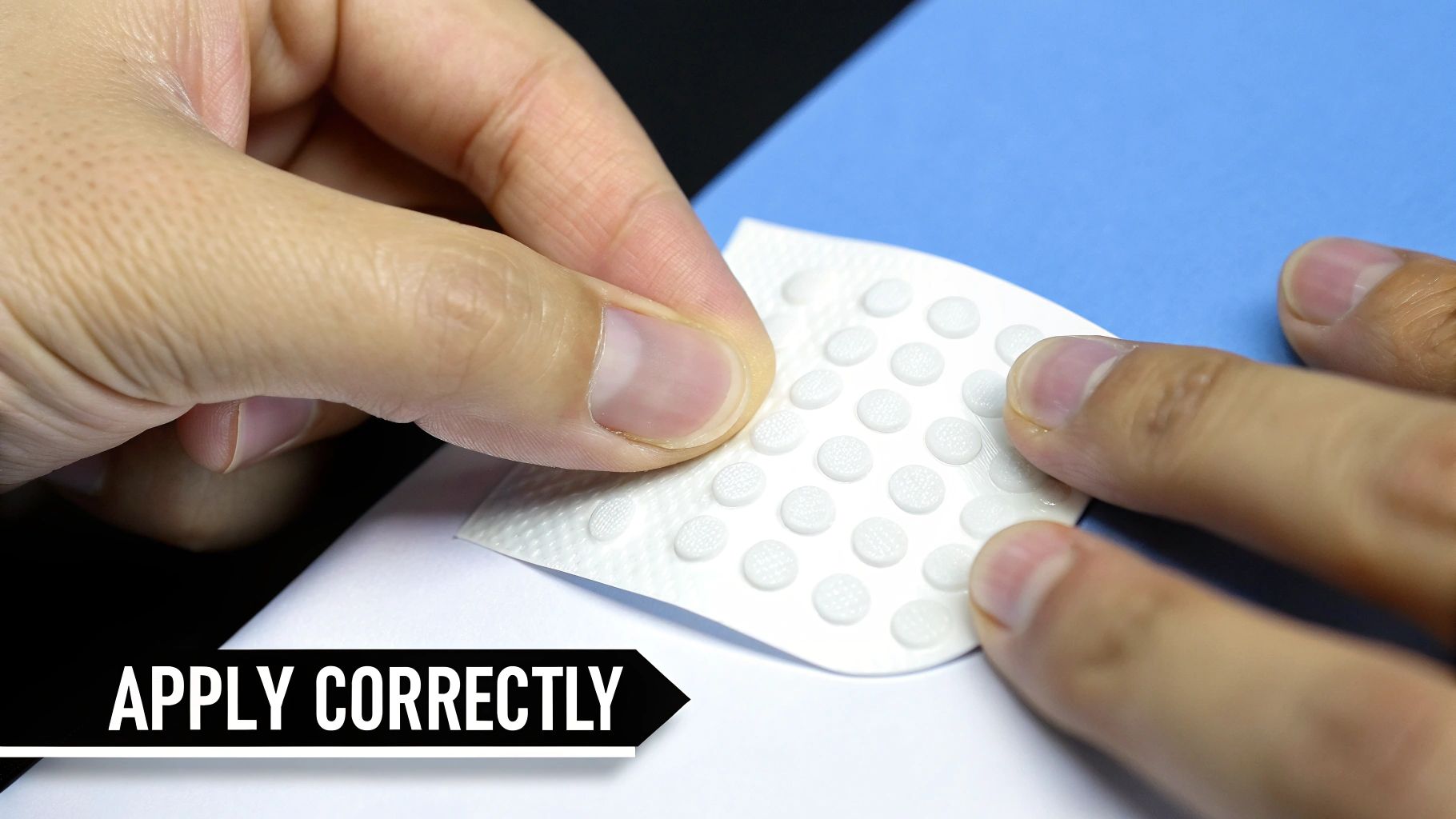
Just slapping a patch on a pimple and hoping for the best won't get you very far. How you apply it makes all the difference, especially if you're wondering do pimple patches work on unpopped pimples. The technique is straightforward, but getting it right is the secret to success.
The golden rule? Always start with a completely clean, bone-dry face. If you put a patch over serums, moisturizers, or even slightly damp skin, you’re just creating a barrier. It's like trying to put a sticker on a wet window—it's never going to stick properly.
That seal is everything. A good seal locks in the active ingredients so they can get down into the pore, and it creates the perfect little bubble for the hydrocolloid to start drawing out all that gunk.
Your Step-by-Step Guide to Applying Pimple Patches
Follow these simple but non-negotiable steps every time you use a patch. This is how you turn a good product into your go-to breakout buster.
-
Cleanse and Dry: Gently wash your face with a mild cleanser and pat the area completely dry. I mean it—any leftover moisture will ruin the patch’s stickiness.
-
Pick the Right Size: Grab a patch that's big enough to cover the entire pimple, plus a little extra around the edges. This helps it get a good grip and seal everything in.
-
Press, Don't Just Pat: Once the patch is on, don't just tap it. Gently press down on it for 10-15 seconds. The warmth from your finger helps the adhesive bond with your skin, creating that all-important airtight seal.
-
Be Patient: Leave it alone for at least 6-8 hours (overnight is perfect). This gives the ingredients plenty of time to work their magic. Don't peel it off early to check on the progress!
Mastering this simple routine is what allows powerful ingredients like Salicylic Acid to really get to the source of the inflammation. When you apply a patch correctly, you're not just covering a pimple—you're giving it exactly what it needs to heal faster and look better.
The Future of Pimple Patches is Here: Microneedles
While medicated hydrocolloid patches are fantastic for surface-level zits, the next generation of spot treatments is already making waves: microneedle patches. Brands like Neutralyze are leading the charge, changing how we think about treating a pimple before it even fully forms.
So, what exactly are they? Picture a tiny patch covered in hundreds of microscopic, painless darts. These aren't sharp needles; they're dissolvable cones made from powerful, skin-clearing ingredients that have been solidified.
Most commonly, they're crafted from things like hyaluronic acid for hydration and salicylic acid to fight acne. When you press the patch onto your skin, these tiny needles painlessly penetrate the very top layer, delivering those active ingredients much deeper than a standard topical cream or patch ever could.
A Deeper, Faster Way to Heal
This technology is a total game-changer, especially for those deep, painful, under-the-skin pimples that you can feel brewing for days. Instead of just sitting on the surface and waiting for ingredients to slowly seep in, microneedle patches create tiny, direct channels to the source of the inflammation.
The result? You get relief delivered right where it’s needed. This means swelling goes down faster, and you have a much better shot at stopping a monster blemish before it ever reaches a head. It's a proactive strike against the toughest pimples to treat.
And the science backs this up. A recent clinical trial looked at a two-step microarray patch system on active, unpopped pimples. The results were pretty staggering: participants saw an 81% reduction in their pimples after only three days. By the one-week mark, the treated blemishes were completely gone for most people. You can dive into the study's findings and see the data for yourself.
Microneedle patches represent a major leap forward in targeted acne care. By delivering key ingredients precisely where they're needed most, they offer a more direct and efficient way to treat unpopped pimples before they surface.
When to Skip the Patch and See a Dermatologist
Pimple patches are fantastic little tools for tackling individual spots, but they definitely have their limits. Knowing when a patch is the right move—and when it’s time to call in a professional—is crucial for keeping your skin healthy.
Think of it this way: a patch is perfect for a surface-level zit or one that's just about to pop up. But for those deep, painful nodules or cystic acne? The problem there is happening way below the skin's surface, far deeper than any patch can penetrate. Patches also won't help with non-inflammatory blemishes like blackheads or whiteheads.
Know When a Patch Just Isn't Enough
A pimple patch is best seen as a spot treatment, a single player on your skincare team. It’s not the whole game plan. If you're seeing any of the following, it’s a clear signal that your skin needs more support than a sticker can offer:
- Widespread or Persistent Acne: Are you constantly fighting breakouts across large areas of your face or body? Patches can't keep up with that.
- Deep, Painful Blemishes: If you're getting cystic acne that's sore to the touch and never seems to come to a head, a patch won’t be able to help.
- Scarring: If your pimples are leaving behind dark spots or pitted scars, it's time for a more aggressive treatment plan to prevent permanent damage.
A dermatologist can put together a routine that addresses the root cause of your acne. Sometimes, the issue goes beyond typical skincare, especially with persistent or unexplained skin issues that might even be linked to things like your diet.
Bottom line: don't be afraid to seek expert advice. If your skin is telling you it needs more help, listen.
Got More Questions About Pimple Patches?
It's totally normal to have a few questions before you start sticking patches on your face. Let's walk through some of the common ones so you can feel like a pro.
How Can You Tell if the Patch Is Actually Working?
You’ll know it’s doing its job when the pimple starts to look and feel better. Look for less redness and swelling. The spot should also feel less tender to the touch and appear noticeably flatter.
If you're using a classic hydrocolloid patch, you'll see a white dot form right in the middle. Don't panic—that's a good thing! It's all the gunk (pus and fluid) the patch has successfully pulled out of the blemish.
What About Those Painful Pimples That Won't Come to a Head?
Yes, you can—and you should! This is the perfect scenario for a medicated or microneedle patch. Those deep, under-the-skin cysts need more than just suction; they need active ingredients that can get below the surface.
A patch with an anti-inflammatory hero like Salicylic Acid, a key ingredient in Neutralyze products, can deliver the treatment right where it's needed to calm things down before the pimple has a chance to erupt. This is the expert approach to handling stubborn acne and achieving clearer skin.
Is It Okay to Wear a Pimple Patch During the Day?
Absolutely. Go for it! Many of today's patches are super thin, clear, and designed to be almost invisible, making them great for daytime wear.
Even better, they act as a physical shield. This keeps your fingers off the spot (no picking!) and protects it from dirt, bacteria, and makeup that could make the inflammation even angrier.
Is It Possible for Pimple Patches to Make Acne Worse?
It’s highly unlikely, but not impossible. Sometimes, a person might have an allergy to the adhesive or one of the active ingredients. More often, the problem comes down to how you put it on.
Always, always apply a patch to skin that is 100% clean and dry. If you trap moisture, sweat, or bacteria under there, you could definitely make the breakout worse. For a broader look at what causes breakouts, this page offers some great general acne information.
Ready to fight those unpopped pimples with the right tools? Neutralyze uses science-backed formulas to calm inflammation and get your skin clear, fast. Find your new go-to acne solutions at https://www.neutralyze.com.
